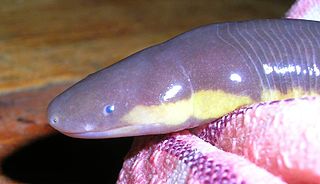
The Ichthyophiidae are the family of Asiatic tailed caecilians or fish caecilians found in South and Southeast Asia as well as southernmost China.
Nesorohyla is a monotypic genus of frogs in the family Hylidae. The sole species is Nesorohyla kanaima, also known as the Kanaima treefrog. It is endemic to Guyana. and possibly Brazil and Venezuela. Its natural habitats are subtropical or tropical moist lowland forests, subtropical or tropical moist montane forests, and rivers.
Ichthyophis asplenius is a species of amphibian in the family Ichthyophiidae found in Malaysia and possibly Thailand. It is also known as broad-striped caecilian, Boven Mahakkam caecilian and Malayan caecilian. It is only known with certainty from Mahakam River and Matang Hunting Reserve Its natural habitats are subtropical or tropical moist lowland forests, rivers, intermittent rivers, plantations, rural gardens, heavily degraded former forest, irrigated land, and seasonally flooded agricultural land.
Ichthyophis nigroflavus, the Kuala Lumpur caecilian, is a species of amphibian in the family Ichthyophiidae endemic to Malaysia. Its natural habitats are subtropical or tropical moist lowland forests, rivers, intermittent rivers, plantations, rural gardens, heavily degraded former forest, irrigated land, and seasonally flooded agricultural land.
Ichthyophis paucidentulus, the Kapahiang caecilian, is a species of amphibian in the family Ichthyophiidae endemic to Indonesia. Its natural habitats are subtropical or tropical moist lowland forests, rivers, intermittent rivers, plantations, rural gardens, heavily degraded former forest, irrigated land, and seasonally flooded agricultural land.
Ichthyophis weberi, the Malatgan River caecilian, is a species of amphibian in the family Ichthyophiidae endemic to the Philippines. Its natural habitats are subtropical or tropical moist lowland forests, subtropical or tropical moist montane forests, rivers, intermittent rivers, plantations, rural gardens, heavily degraded former forests, irrigated land, and seasonally flooded agricultural land.
The pointed-headed caecilian, Ichthyophis acuminatus, is a species of amphibian in the family Ichthyophiidae endemic to Thailand. Its natural habitats are subtropical or tropical moist lowland forests, subtropical or tropical moist montane forests, rivers, intermittent rivers, plantations, rural gardens, heavily degraded former forest, irrigated land, and seasonally flooded agricultural land.

Ichthyophis bannanicus, the Banna caecilian, is a species of amphibians in the family Ichthyophiidae found in southern China and northern Vietnam, presumably also in adjacent eastern Myanmar and northern Laos. Its natural habitats are subtropical or tropical moist lowland forests, rivers, intermittent rivers, plantations, rural gardens, heavily degraded former forest, irrigated land, and seasonally flooded agricultural land. It is threatened by habitat loss.
Ichthyophis bernisi, the Indonesian caecilian, is a species of amphibian in the family Ichthyophiidae endemic to Indonesia. Its natural habitats are subtropical or tropical moist lowland forests, subtropical or tropical moist montane forests, rivers, intermittent rivers, plantations, rural gardens, heavily degraded former forest, irrigated land, and seasonally flooded agricultural land.
Ichthyophis biangularis, the angular caecilian or Metang caecilian, is a species of amphibian in the family Ichthyophiidae endemic to Borneo (Malaysia): it is only known from its type locality, Mount Matang in Sarawak, where the holotype was collected in 1872 by Alfred Hart Everett. New specimens were collected from the type locality only in 2009. In addition, one larval sample was collected from the same region and identified as likely Ichthyophis biangularis using genetic methods.
Ichthyophis glandulosus, the Basilan Island caecilian, is a species of amphibian in the family Ichthyophiidae endemic to the Philippines. Its natural habitats are subtropical or tropical moist lowland forests, subtropical or tropical moist montane forests, rivers, intermittent rivers, freshwater springs, plantations, rural gardens, heavily degraded former forest, irrigated land and seasonally flooded agricultural land. The population is unknown as only two specimens have been collected.

Ichthyophis glutinosus, the Ceylon caecilian or common yellow-banded caecilian, is a species of caecilian in the family Ichthyophiidae endemic to Sri Lanka. Its natural habitats are moist tropical and subtropical forests and pastures.
The Javan caecilian is a species of amphibian in the family Ichthyophiidae endemic to Indonesia. Its natural habitats are subtropical or tropical moist lowland forests, subtropical or tropical moist montane forests, rivers, intermittent rivers, plantations, rural gardens, heavily degraded former forests, irrigated land, and seasonally flooded agricultural land.

The Koh Tao Island caecilian, Ichthyophis kohtaoensis, is a species of amphibian in the family Ichthyophiidae found in Cambodia, Laos, Myanmar, Thailand, and Vietnam. Its natural habitats are subtropical or tropical moist lowland forests, subtropical or tropical moist montane forests, rivers, intermittent rivers, swamps, freshwater marshes, intermittent freshwater marshes, plantations, rural gardens, urban areas, heavily degraded former forests, irrigated land, and seasonally flooded agricultural land.

Ichthyophis paucisulcus, the Siantar caecilian, is a species of amphibian in the family Ichthyophiidae found in Indonesia and Singapore. Its natural habitats are subtropical or tropical moist lowland forests, subtropical or tropical swamps, rivers, intermittent rivers, plantations, rural gardens, heavily degraded former forests, seasonally flooded agricultural land, and canals and ditches.
Ichthyophis singaporensis, the Singapore caecilian, is a species of amphibian in the family Ichthyophiidae endemic to Singapore. Its natural habitats are subtropical or tropical moist lowland forests, rivers, intermittent rivers, plantations, rural gardens, heavily degraded former forests, irrigated land, and seasonally flooded agricultural land.

Amnirana darlingi, commonly known as Darling's golden-backed frog, is a species of frogs in the family Ranidae. It is found in eastern Angola, the Caprivi Strip of Namibia, extreme northern Botswana, extreme southern Democratic Republic of the Congo, Zambia, eastern and northern Zimbabwe, southern Malawi, and west-central Mozambique.

The Mascarene grass frog, or Mascarene ridged frog, is a species of frog in the family Ptychadenidae. It is found in sub-Saharan Africa, Madagascar, and Mauritius.
Ptychadena tellinii is a species of frog in the family Ptychadenidae. It is found in Burkina Faso, Cameroon, Central African Republic, Democratic Republic of the Congo, Ivory Coast, Eritrea, Ethiopia, Ghana, Mali, Nigeria, Sierra Leone, Togo, possibly Benin, possibly Chad, possibly Guinea, possibly Liberia, and possibly Sudan.
Philautus larutensis is a species of frog in the family Rhacophoridae. It is endemic to Indonesia.








